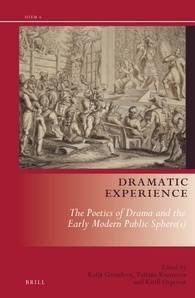 Over the last decade, Brill’s Drama and Theatre in Early Modern Europe-series has established a reputation in the study of early modern vernacular and Neolatin dramatic theory and performance, particularly on the Continent. The present volume, the outcome of a conference of the Early Modern European Drama and the Cultural Net project at the Freie Universität Berlin, makes a solid contribution to an already strong series. In eleven chapters spanning a wide geographical area ranging from Italy, Germany and France to Russia and examining an equally wide range of historical contexts and methodological approaches, the editors seek to examine ‘how the convergence of dramatic theory, theatrical practice and various modes of audience experience’ (1) worked to shape audiences into publics, and contributed to the rise of a public sphere, or perhaps more correctly, public spheres. The volume is prefaced by an introduction of admirable clarity and concision that establishes the shaping intellectual paradigms of the book: the scholarship on the public sphere in early modern Europe that developed in response to Habermas’ Strukturwandel der Offentlichkeit, the work of Joachim Küper on early modern drama as massmedium, and the work of Carl Schmitt, Walter Benjamin, Louis Marin and Hélène Merlin Kajman on the theatrical construction of sovereignty.
Over the last decade, Brill’s Drama and Theatre in Early Modern Europe-series has established a reputation in the study of early modern vernacular and Neolatin dramatic theory and performance, particularly on the Continent. The present volume, the outcome of a conference of the Early Modern European Drama and the Cultural Net project at the Freie Universität Berlin, makes a solid contribution to an already strong series. In eleven chapters spanning a wide geographical area ranging from Italy, Germany and France to Russia and examining an equally wide range of historical contexts and methodological approaches, the editors seek to examine ‘how the convergence of dramatic theory, theatrical practice and various modes of audience experience’ (1) worked to shape audiences into publics, and contributed to the rise of a public sphere, or perhaps more correctly, public spheres. The volume is prefaced by an introduction of admirable clarity and concision that establishes the shaping intellectual paradigms of the book: the scholarship on the public sphere in early modern Europe that developed in response to Habermas’ Strukturwandel der Offentlichkeit, the work of Joachim Küper on early modern drama as massmedium, and the work of Carl Schmitt, Walter Benjamin, Louis Marin and Hélène Merlin Kajman on the theatrical construction of sovereignty.
The essays are almost without exception extensively researched, insightful, and at times innovative in their approaches. Deborah Blocker’s chapter on Jacopo Peri and Ottaviano Rinuccini’s musical drama Euridice, performed at the wedding of Maria de’ Medici to Henry IV of France, is a test-case example of the gains to be had from combining meticulous historical contextualization with attention to poetics and staged performance. Connecting the performance to the poetic and political views current within circles of the Florentine Academia degli Alterati, with which Rinuccini was associated, Blocker argues that the drama figures the relationship between the political power of the Medici court and its poets, musicians and patrons, in a way that emphasises the autonomous creative power of an art. The Italian Academies, in this case the Sienese Accademia degli Intronati, are also central to Katja Gvozdeva’s stimulating chapter on gender riddles and fool’s play in the comedy Gli’Ingannati (1532), that ought to find an audience reaching beyond scholars of Italian drama, to those interested in Renaissance cross-dressing performances on stage. In a carefully constructed argument that combines an anthropological perspective on the function of societies like the Intronati with an analysis of the comedy’s structural form, Gvozdeva claims the actions of the comedy’s cross-dressing heroine should not be seen as an exploration of gender ambiguity, but presents a visual and verbal riddle that works on several levels. Thus, Gozdeva argues that the ritual logic of the comedy shows us that the ambiguity created through the staging of cross-dressing is a ‘controlled uncertainty’ of public events that performs a similar function to that of rites of passage (71).
Both the contributions of Gozdeva and Blocker; Kilian’s chapter on the creation of reading audiences in De Rojas’ Celestina and Machiavelli’s Mandragora, and that of Tatiana Korneeva on Carlo Gozzi’s L’amore delle tre melarance show the multiple, complex and overlapping forms in which the early modern publics took shape, and the complexity of the relationship between political power and artistic creation. Other essays, such as Hans Rudolf Velten’s essay on devils on- and off-stage in early modern Germany and Toni Bernhart’s contribution on popular theatre in Tirol examine the formation of audience into public from an urban or regional perspective. Kirill Ospovat and Nigel Smith’s chapters, by contrast, both focus their approach directly on the theatre’s relationship to sovereign power. Ospovat’s illuminating contribution on Sumarokov’s Russian adaptation of Hamlet, Gamlet (1748), a play that is commonly understood to dramatically re-enact Empress Elizabeth’s coup d’état, focusses on the play’s most significant departures from its source: Gamlet’s decision to condemn, and ultimately pardon, the guilty Polonii/Polonius. Examining the political context of the Elizabeth’s coup and the dramatical explorations of theme of royal pardon, such as Corneille’s Cinna and La Clemenza di Tito, Ospovat’s chapter explores the ambivalences of clemency as a marker both of absolute power and divine mercy, a highly theatrical effect ‘that grounds sovereignty in a strong emotional affect that is evoked among the publics both on and off stage’ (209). Nigel Smith’s learned and deeply-researched essay on a martyr-drama about the assassination (lynching) of the brothers De Witt by the Dutch Collegiant Joachim Oudaen, Haagsche broeder-moord, of dolle blydschap (Fratricide at The Hague, or, Mad Joy) (1673) offers an powerful counterpoint to Ospovat’s essay, by showing how Oudaen, a supporter of the De Witt-regime, intended his play not merely as a political statement, but as an aesthetic reflection on, and condemnation of, ethics of political violence.
To both these essays and the purpose of the volume as a whole, Stanca Scholz-Cionca’s essay on nô theatre as cultural capital offers an illuminating comparison. Her contribution shows how during the Edo period nô gained heightened political significance as an instrument for the Shogunate to strengthen their dominance over the provincial powerholders, and as a tool for the self-fashioning of the Samurai elites, to the exclusion of the wider populace, who were increasingly reduced to the role of occasional, passive spectators. Despite these strictures, the influence of nô nevertheless extended downwards through a variety of other theatrical forms such as kabuki and puppet theatre, through the circulation of printed nô texts and practice of the chanting, thus contributing to formation of a national culture.
There are also some quibbles. The volume is heavily weighted towards Italian drama, a decision which the editors defend on grounds of Italy’s dominating position both in terms of theatrical production and poetics and criticism. While this is no doubt true, a distribution of five out of eleven essays nevertheless feels somewhat unbalanced. Seeing the powerful cultural influence radiating outwards from the French court at Versailles, and the impact of French dramatists such as Corneille and Racine and dramatic theorists such as André Dacier, it is somewhat of a pity that the only essay on French drama, by Logan J. Connors, although lucidly written, is rather on the short side. Another question that remains unaddressed is that of the dialectical tension between the development of distinct national theatre cultures, and the international dimension of certain forms of theatrical practice, such as the translation of Spanish playwrights such as Lope Vega and Calderon into English or Dutch, or the activities of the strolling players; or between the national and regional public spheres, and the transnational public spheres created by the confessional conflicts of the Reformation and the Thirty Years’ War. Another question about the nature of the early modern public sphere is the absence of religion from most of the essays. Pointing to the lacunae in an otherwise varied and diverse collection of essays is always a bit of a shot into an open goal. But in a volume which expressly addresses the question of the creation of publics, the absence of a consideration of the role of Jesuit drama, or of that of the auto sacramental, is nevertheless striking, making the reader wonder about the implicit assumptions about the nature of the public sphere at work here. Despite these reservations, this is a stimulating and thought-provoking book, which will be gratefully received by scholars of early modern drama eager to look across the boundaries of their own specialism.
Freya Sierhuis
Katja Gvozdeva, Tatiana Korneeva & Kirill Ospovat (red.), Dramatic Experience. The Poetics of Drama and the Early Modern Public Sphere(s). Leiden: Brill, 2017. 328 pp. isbn: 9789004329751. € 149,–.
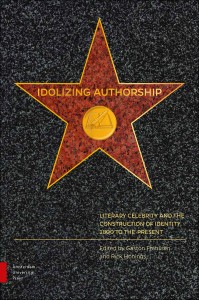 Idolizing Authorship places itself on the borderlands between the sociology of literature, celebrity studies and good old hermeneutics. Throughout eleven case studies, delivered by as many scholars, the phenomenon of the ‘star author’ is approached from a variety of angles. Analyses are given of, for example, the ‘posture’ – i.e. the different discursive and non-discursive expressions surrounding an authorship, meant to make clear what kind of author we are dealing with – of such authors. Or of the ‘fan culture’ surrounding them, both while they were alive and posthumously. Or of their literary and nonliterary texts, which some contributors to the volume interpret as explorations of the theme of literary celebrity. The result is an exciting, kaleidoscopic exploration of, as the volume’s subtitle has it, ‘literary celebrity and the construction of identity’.
Idolizing Authorship places itself on the borderlands between the sociology of literature, celebrity studies and good old hermeneutics. Throughout eleven case studies, delivered by as many scholars, the phenomenon of the ‘star author’ is approached from a variety of angles. Analyses are given of, for example, the ‘posture’ – i.e. the different discursive and non-discursive expressions surrounding an authorship, meant to make clear what kind of author we are dealing with – of such authors. Or of the ‘fan culture’ surrounding them, both while they were alive and posthumously. Or of their literary and nonliterary texts, which some contributors to the volume interpret as explorations of the theme of literary celebrity. The result is an exciting, kaleidoscopic exploration of, as the volume’s subtitle has it, ‘literary celebrity and the construction of identity’.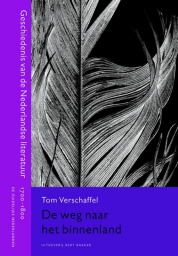 In 2004 gaf Joost Kloek zijn afscheidscollege aan de Universiteit Utrecht over de achttiende-eeuwse literatuur van Noord en Zuid als ‘een scheiding van tafel en bed’. Het is de eeuw waarin Noord en Zuid in literair opzicht ieder huns weegs gingen. In het Noorden had men geen benul van de literaire ontwikkelingen in het Zuiden en omgekeerd keek men in het Zuiden nauwelijks nog naar de literatuur van het Noorden. Kloeks idee van een scheiding lijkt bevestigd te worden door de twee delen die nodig bleken om de geschiedenis van de achttiende eeuw te beschrijven in de nieuwe Nederlandse literatuurgeschiedenis. In 2013 verscheen het alom geprezen deel over het Noorden (Worm en donder van Inger Leemans en Gert-Jan Johannes) en dit jaar zag De weg naar het binnenland van Tom Verschaffel het licht. In dit belangrijke pionierswerk biedt Verschaffel een uniek overzicht van de achttiende-eeuwse literatuur van het Zuiden, daarbij puttend uit veel eigen onderzoek en enkele oudere pioniersstudies als die van Jozef Smeyers.
In 2004 gaf Joost Kloek zijn afscheidscollege aan de Universiteit Utrecht over de achttiende-eeuwse literatuur van Noord en Zuid als ‘een scheiding van tafel en bed’. Het is de eeuw waarin Noord en Zuid in literair opzicht ieder huns weegs gingen. In het Noorden had men geen benul van de literaire ontwikkelingen in het Zuiden en omgekeerd keek men in het Zuiden nauwelijks nog naar de literatuur van het Noorden. Kloeks idee van een scheiding lijkt bevestigd te worden door de twee delen die nodig bleken om de geschiedenis van de achttiende eeuw te beschrijven in de nieuwe Nederlandse literatuurgeschiedenis. In 2013 verscheen het alom geprezen deel over het Noorden (Worm en donder van Inger Leemans en Gert-Jan Johannes) en dit jaar zag De weg naar het binnenland van Tom Verschaffel het licht. In dit belangrijke pionierswerk biedt Verschaffel een uniek overzicht van de achttiende-eeuwse literatuur van het Zuiden, daarbij puttend uit veel eigen onderzoek en enkele oudere pioniersstudies als die van Jozef Smeyers.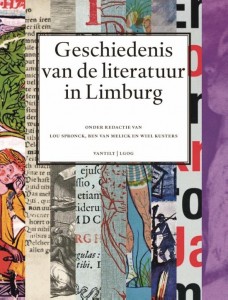 De Geschiedenis van de literatuur in Limburg is een kloek boekdeel van 770 bladzijden, onder redactie van Lou Spronck, Ben van Melick en Wiel Kusters. Het is chronologisch opgebouwd en bestaat uit vier delen die elk weer zijn onderverdeeld in één of meer, in totaal negen periodes. Elk van deze periodes wordt beschreven door een andere auteur. Deel 1: a. tot 1500 (Ludo Jongen), b. 1500-1793 (Herman van Horen & Hannie van Horen-Verhoosel). Deel 2: 1793-1893 (Lou Spronck). Deel 3: 1893-1945, onderverdeeld in a. 1893-1914 (Peter Winkels), b. 1914- 1940 (Wiel Kusters) en c. 1940-1945 (Jos Perry). Deel 4: 1945-2015, onderverdeeld in 1945-1965, 1965-1990 en 1990-2015 (alle door Ben van Melick).
De Geschiedenis van de literatuur in Limburg is een kloek boekdeel van 770 bladzijden, onder redactie van Lou Spronck, Ben van Melick en Wiel Kusters. Het is chronologisch opgebouwd en bestaat uit vier delen die elk weer zijn onderverdeeld in één of meer, in totaal negen periodes. Elk van deze periodes wordt beschreven door een andere auteur. Deel 1: a. tot 1500 (Ludo Jongen), b. 1500-1793 (Herman van Horen & Hannie van Horen-Verhoosel). Deel 2: 1793-1893 (Lou Spronck). Deel 3: 1893-1945, onderverdeeld in a. 1893-1914 (Peter Winkels), b. 1914- 1940 (Wiel Kusters) en c. 1940-1945 (Jos Perry). Deel 4: 1945-2015, onderverdeeld in 1945-1965, 1965-1990 en 1990-2015 (alle door Ben van Melick).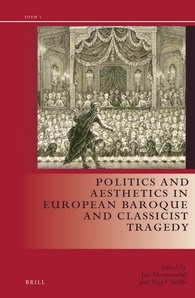 Politics and Aesthetics in European Baroque and Classicist Tragedy, edited by Jan Bloemendal and Nigel Smith, is a collection of 15 essays (the first of which is an extensive introduction by the editors) investigating the nature and uses of tragedy in a number of European countries in the early modern period. The focus is overwhelmingly on the seventeenth century; the final two essays address the eighteenth century. Most of the contributions strongly bring out the political implications of the tragic genre. By comparison, the ‘aesthetics’ of the title are less obviously represented; this volume is largely concerned with dramatic responses to and investigations of tyranny, sovereignty and resistance.
Politics and Aesthetics in European Baroque and Classicist Tragedy, edited by Jan Bloemendal and Nigel Smith, is a collection of 15 essays (the first of which is an extensive introduction by the editors) investigating the nature and uses of tragedy in a number of European countries in the early modern period. The focus is overwhelmingly on the seventeenth century; the final two essays address the eighteenth century. Most of the contributions strongly bring out the political implications of the tragic genre. By comparison, the ‘aesthetics’ of the title are less obviously represented; this volume is largely concerned with dramatic responses to and investigations of tyranny, sovereignty and resistance.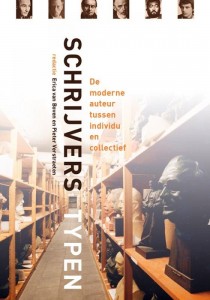 ‘De auteur is […] vandaag weer helemaal terug als een – misschien wel: dé – centrale categorie in de wetenschappelijke literatuurbeschouwing’ (7). Dat stellen Erica van Boven en Pieter Verstraeten, samenstellers van Schrijverstypen. De moderne auteur tussen individu en collectief, uitgegeven ter gelegenheid van het emeritaat van hoogleraar Moderne Nederlandse letterkunde Gillis Dorleijn en diens afscheid van de Rijksuniversiteit Groningen. De ‘revival’ van het onderzoek naar auteurschap vormde voor de redacteuren aanleiding om in de bundel ‘verschillende dimensies van een complexe auteursfunctie in kaart te proberen te brengen’ (8), waarbij het draait om uniciteit versus collectiviteit. Daarmee kondigen zij een vruchtbare insteek aan. Wat daarbij echter mist, is een stevige theoretische verantwoording.
‘De auteur is […] vandaag weer helemaal terug als een – misschien wel: dé – centrale categorie in de wetenschappelijke literatuurbeschouwing’ (7). Dat stellen Erica van Boven en Pieter Verstraeten, samenstellers van Schrijverstypen. De moderne auteur tussen individu en collectief, uitgegeven ter gelegenheid van het emeritaat van hoogleraar Moderne Nederlandse letterkunde Gillis Dorleijn en diens afscheid van de Rijksuniversiteit Groningen. De ‘revival’ van het onderzoek naar auteurschap vormde voor de redacteuren aanleiding om in de bundel ‘verschillende dimensies van een complexe auteursfunctie in kaart te proberen te brengen’ (8), waarbij het draait om uniciteit versus collectiviteit. Daarmee kondigen zij een vruchtbare insteek aan. Wat daarbij echter mist, is een stevige theoretische verantwoording.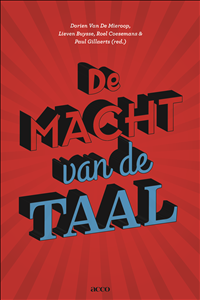 Sinds taalfilosoof John Austin in zijn How to do things with words (1962) taal als performatieve kracht beschreef heeft de studie van taalgebruik en de impact ervan op het sociale leven een uiterst hoge vlucht genomen. De ‘discursieve wending’ in de humane en sociale wetenschappen heeft er verder voor gezorgd dat (de studie van) taalgebruik vandaag een centrale plaats inneemt in de analyse van politieke en economische machtsverhoudingen. Het boek De macht van de taal mag een waardevolle bijdrage heten aan deze evolutie. Het slaagt er met verve in om onderzoekers uit verschillende disciplines (argumentatieleer, tekstwetenschap, corpuslinguïstiek, experimentele pragmatiek) te doen reflecteren over de impact, aanlokkelijkheid en overredingskracht van taal. Het doet dit bovendien op een in zowat alle hoofdstukken hoogstaand wetenschappelijke manier en in een secure, lenige schrijfstijl.
Sinds taalfilosoof John Austin in zijn How to do things with words (1962) taal als performatieve kracht beschreef heeft de studie van taalgebruik en de impact ervan op het sociale leven een uiterst hoge vlucht genomen. De ‘discursieve wending’ in de humane en sociale wetenschappen heeft er verder voor gezorgd dat (de studie van) taalgebruik vandaag een centrale plaats inneemt in de analyse van politieke en economische machtsverhoudingen. Het boek De macht van de taal mag een waardevolle bijdrage heten aan deze evolutie. Het slaagt er met verve in om onderzoekers uit verschillende disciplines (argumentatieleer, tekstwetenschap, corpuslinguïstiek, experimentele pragmatiek) te doen reflecteren over de impact, aanlokkelijkheid en overredingskracht van taal. Het doet dit bovendien op een in zowat alle hoofdstukken hoogstaand wetenschappelijke manier en in een secure, lenige schrijfstijl.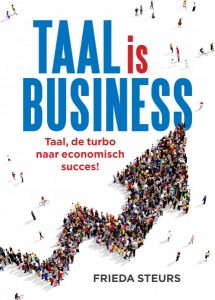 Het primaire doel van dit prachtige in kleurendruk uitgegeven boek is de lezers te overtuigen van de belangrijke rol die taal en communicatie in het bedrijfsleven spelen. Het boek is bedoeld voor een breed publiek. Professionals van organisaties geeft het een up-to-date inzicht in een caleidoscoop van taal- en communicatieaspecten die economisch succes kunnen bevorderen: van het aanpassen van de marketing van een product aan een andere cultuur (transcreatie) tot de toepassing van taaltechnologie in de bediening van rolstoelen. Taal is business geeft potentiële studenten tolk, vertaler, interculturele en meertalige communicatie, taaltechnologie, enz. inzicht in deze vakgebieden en de terreinen waarop ze zouden kunnen gaan werken. Het boek is geschreven in het Nederlands en geeft veel voorbeelden uit het Nederlandse taalgebied. Daardoor is het niet alleen interessant voor professionals in Vlaanderen en Nederland, maar is het ook een uitstekende inleiding in de relatie tussen taal, communicatie en economie voor studenten aan Belgische en Nederlandse hogescholen en universiteiten. In twaalf hoofdstukken wordt de lezer geloodst door wat de auteur bestempelt als ‘een boeiend economisch verhaal over de maatschappelijke en economische aspecten van taal’ (p. 9).
Het primaire doel van dit prachtige in kleurendruk uitgegeven boek is de lezers te overtuigen van de belangrijke rol die taal en communicatie in het bedrijfsleven spelen. Het boek is bedoeld voor een breed publiek. Professionals van organisaties geeft het een up-to-date inzicht in een caleidoscoop van taal- en communicatieaspecten die economisch succes kunnen bevorderen: van het aanpassen van de marketing van een product aan een andere cultuur (transcreatie) tot de toepassing van taaltechnologie in de bediening van rolstoelen. Taal is business geeft potentiële studenten tolk, vertaler, interculturele en meertalige communicatie, taaltechnologie, enz. inzicht in deze vakgebieden en de terreinen waarop ze zouden kunnen gaan werken. Het boek is geschreven in het Nederlands en geeft veel voorbeelden uit het Nederlandse taalgebied. Daardoor is het niet alleen interessant voor professionals in Vlaanderen en Nederland, maar is het ook een uitstekende inleiding in de relatie tussen taal, communicatie en economie voor studenten aan Belgische en Nederlandse hogescholen en universiteiten. In twaalf hoofdstukken wordt de lezer geloodst door wat de auteur bestempelt als ‘een boeiend economisch verhaal over de maatschappelijke en economische aspecten van taal’ (p. 9).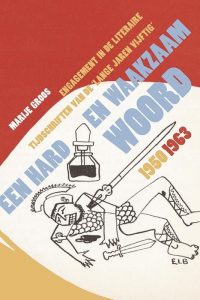 In 2016 promoveerde Marije Groos in Leiden op Een hard en waakzaam woord. Engagement in de literaire tijdschriften van de ‘lange jaren vijftig’ (1950-1963). Groos onderzoekt in haar proefschrift hoe het ‘literaire engagement’, een fenomeen op het grensvlak van literatuur en maatschappij, zich ontwikkelde in het literaire veld van de jaren vijftig. Het boek bestaat uit een theoretische inleiding die gevolgd wordt door drie hoofdstukken die drie kernvragen uit het politieke debat van de jaren vijftig aan de orde stellen: het herdenken van en getuigen over de Tweede Wereldoorlog, de reacties op het proces van dekolonisatie en de Koude Oorlog. Steeds is de vraag hoe er in de belangrijkste literaire tijdschriften uit deze perioden expliciet en impliciet op de politieke ontwikkeling werd gereageerd.
In 2016 promoveerde Marije Groos in Leiden op Een hard en waakzaam woord. Engagement in de literaire tijdschriften van de ‘lange jaren vijftig’ (1950-1963). Groos onderzoekt in haar proefschrift hoe het ‘literaire engagement’, een fenomeen op het grensvlak van literatuur en maatschappij, zich ontwikkelde in het literaire veld van de jaren vijftig. Het boek bestaat uit een theoretische inleiding die gevolgd wordt door drie hoofdstukken die drie kernvragen uit het politieke debat van de jaren vijftig aan de orde stellen: het herdenken van en getuigen over de Tweede Wereldoorlog, de reacties op het proces van dekolonisatie en de Koude Oorlog. Steeds is de vraag hoe er in de belangrijkste literaire tijdschriften uit deze perioden expliciet en impliciet op de politieke ontwikkeling werd gereageerd.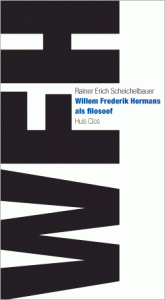 Willem Frederik Hermans uitte weinig anders dan dedain voor de wijsbegeerte. Wat hem betreft, was de filosofie vooral goed in het bedenken van waangedachten en drogredeneringen, net zoals ethiek, religie en politiek. Hooguit hebben deze collectieve mythe-producenten een psychologische nutsfunctie: ze scheppen orde in een wereld die vanuit menselijk perspectief anders maar hopeloos chaotisch blijft. Hermans:
Willem Frederik Hermans uitte weinig anders dan dedain voor de wijsbegeerte. Wat hem betreft, was de filosofie vooral goed in het bedenken van waangedachten en drogredeneringen, net zoals ethiek, religie en politiek. Hooguit hebben deze collectieve mythe-producenten een psychologische nutsfunctie: ze scheppen orde in een wereld die vanuit menselijk perspectief anders maar hopeloos chaotisch blijft. Hermans: